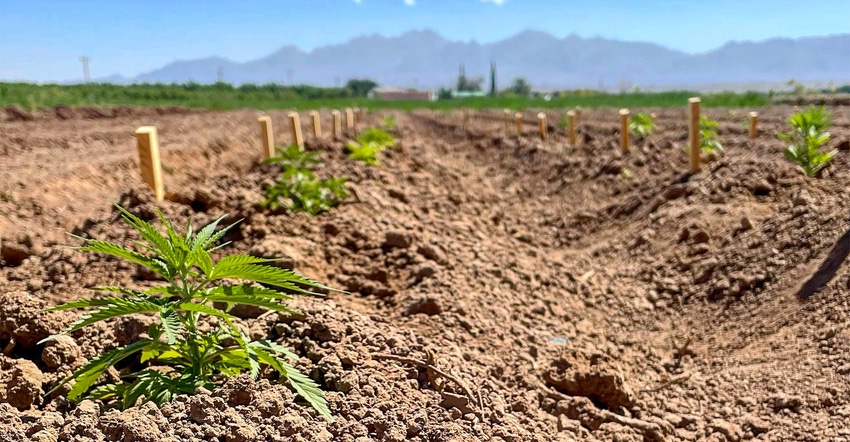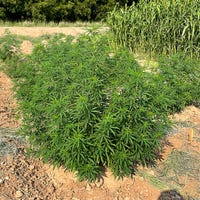August 17, 2021

In 2019, faculty in the College of Agricultural, Consumer and Environmental Sciences at New Mexico State University were given the go-ahead by state officials to begin research into hemp cultivation, which became legal to grow that same year. Since then, research efforts have focused on understanding hemp agronomics under a regulatory system established by the New Mexico Department of Agriculture.
In southern New Mexico, NMSU has partnered with growers such as Las Cruces-based Rich Global Hemp to help them understand the area’s soil quality.
“In 2019, when growing hemp became legal, there was a tremendous number of farmers who got into it but didn’t realize what they were in for,” said Jeffrey Anderson, agronomy and horticulture agent for the Doña Ana County Cooperative Extension Service. “Hemp has nutritional deficiencies they didn’t know about, and those who were good enough farmers were able to recognize and correct it.”
Renewed interest
Anderson said he’s recently seen a renewed interest in companies looking to grow hemp in the area, but he cautions certain areas of New Mexico are more amenable to certain forms of hemp and hemp products than others.
 Research efforts by New Mexico State University faculty have focused on understanding hemp agronomics under a regulatory system by the New Mexico Department of Agriculture. Hemp is grown throughout New Mexico, with some areas more suitable to various types of hemp plants. (NMSU photo by Hanah Rheay)
Research efforts by New Mexico State University faculty have focused on understanding hemp agronomics under a regulatory system by the New Mexico Department of Agriculture. Hemp is grown throughout New Mexico, with some areas more suitable to various types of hemp plants. (NMSU photo by Hanah Rheay)
“As you go north, hemp is easier to grow outdoors than here,” Anderson said. “Right now, there’s a glut in hemp CBD oil because there’s not enough processors to deal with it.”
Anderson wants to bring back NMSU’s hemp conference, and is planning an in-person conference for 2022.
While there continues to be enthusiasm surrounding the possibilities of hemp cultivation in New Mexico, more research needs to be done regarding risks and benefits, and on how guidelines and policy should be developed across the state, including the Navajo Nation, said Kevin Lombard, superintendent of the NMSU Agricultural Science Center, Farmington, and associate professor of horticulture in the NMSU Department of Plant and Environmental Sciences.
In northern New Mexico, the Agricultural Science Center at Farmington is the only one within the NMSU Agricultural Experiment Station system west of the Continental Divide, and the only 1862 land-grant science center to work directly on sovereign First Nations – Navajo Nation – land. Unique research taking place at the center includes potatoes, corn, alfalfa, small grains, fruit crops and hops.
Until recently, hemp was grown in Farmington. Lombard said the ASC is taking a break from plot work. Two years ago, NMSU signed a memorandum of understanding with the Navajo Agricultural Products Industry to explore the feasibility of growing hemp in Northwest New Mexico.
Since then, Lombard and a team of researchers and members of the Navajo Agricultural Products Industry, have focused their study on three hemp cultivars – Cherry Wine, Sweetened and Wife – to determine whether they could be grown within state THC harvest requirements of at or below 0.3%.
“The most active interest in New Mexico hemp production is currently CBD extraction and many other proclaimed health, food, fiber and industrial uses,” Lombard said.
CBD
CBD is a medicinal compound of hemp that is used in the FDA-approved Epidiolex anti-epileptic medication.
“Overall, the first year was successful in terms of beginning to better understand hemp agronomics within the context of a newly established regulatory system,” Lombard said.
Lombard added that more research and education is needed to help growers determine if hemp is the right crop for them.
“The volatility of hemp is a huge risk that growers need to consider,” Lombard said. “There are new federal guidelines that went into effect in March. You have to educate yourself in everything you do with hemp.
“Research has not caught up with grower enthusiasm. Research efforts should be rapidly scaled up to give growers the most informed information to allow growers to decide if hemp is right for them in a rotational-based cropping system. There are other aspects of hemp that also should be considered, including understanding cultural, social and community norms, odor and regulatory systems that protect everyone, not just hemp growers.”
The NMSU Cooperative Extension Service hosted a series of workshops to help stakeholders learn more about the emerging crop for agriculture producers in the state. Researchers Catie Brewer and Rebecca Creamer are scheduled to speak about hemp research at the upcoming field days in Los Lunas Aug. 18, and at the Leyendecker Plant Science Center in La Mesa, New Mexico, Aug. 25.
Creamer said changes this year include three hemp variety trials at Leyendecker, Los Lunas and Alcalde, including hemp varieties for CBD production, grain and fiber.
“We are also monitoring the trials for diseases and insect pests,” Creamer said. “The trials were initiated to help growers, as well as extension agents, get a better understanding of how different hemp types and varieties would do at different locations in the state.”
Source: is NMSU, which is solely responsible for the information provided and is wholly owned by the source. Informa Business Media and all its subsidiaries are not responsible for any of the content contained in this information asset.
You May Also Like




